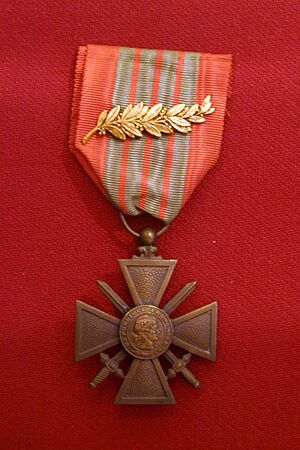Agnès Humbert facts for kids
Quick facts for kids
Agnès Humbert
|
|
|---|---|
| Born |
Agnès Dorothée Humbert
12 October 1894 |
| Died | 19 September 1963 (aged 68) Valmondois (Val d'Oise), France
|
| Nationality | French |
| Other names | Agnès Sabbagh, Agnès Sabbert |
| Occupation | Art historian and ethnographer |
Agnès Humbert (born October 12, 1894 – died September 19, 1963) was a brave French woman. She was an expert in art history and culture. During World War II, she joined the French Resistance. This secret group fought against the Nazi occupation of France. Agnès became famous for a diary she wrote. It shared her experiences during the war and her time in German prisons.
Contents
About Agnès Humbert
Her Early Life and Studies
Agnès Dorothée Humbert was born in Dieppe, France, on October 12, 1894. Her father, Charles Humbert, was a French senator. Her mother, Mabel Wells Annie Rooke, was an English writer.
Agnès grew up in Paris. She studied painting and design there. In 1916, she married Georges Hanna Sabbagh. She continued to paint, using the name Agnès Sabbert. They had two sons, Jean Sabbagh and Pierre Sabbagh. Agnès and Georges later divorced in 1934.
From 1929, Agnès studied art history at the Sorbonne and the Louvre school. She also studied philosophy and ethnography. Ethnography is the study of different cultures. She then worked as an art historian at the Musée national des Arts et Traditions Populaires. This museum was in Paris.
Her first book was about the painter Louis David. It was published in 1936. She also talked about art on Radio Paris in 1936.
Fighting Back: The French Resistance
When Paris fell to the Nazis in June 1940, Agnès started writing a secret diary. She kept writing until she was arrested in April 1941. She did not write again until she was freed from prison in April 1945.
The Nazis Take Over Paris
After Paris was taken over, Agnès heard General Charles de Gaulle on the BBC. He asked the French people to keep fighting the Germans. Agnès was upset when the Germans removed books from her library. They even added German authors.
On August 6, 1940, a sign was put up at the Palais de Chaillot. It said German soldiers could enter for free. Agnès felt she had to do something. So, she and her colleagues formed the Groupe du musée de l'Homme. This was one of the first resistance groups in France.
They quickly built a secret network. They created a hidden newsletter called Résistance. It had five issues between December 1940 and March 1941. The newsletter told people the truth about the German occupation. This group also sent important information to the British.
Arrest, Trial, and Imprisonment
The leaders of Agnès's resistance group were betrayed. They were arrested in April 1941. Agnès helped publish the last issue of Résistance. Soon after, she was arrested too.
The Museum group members were sent to harsh prisons in Paris. In February 1942, seven men from the group were sentenced to death. Agnès was moved to a different prison. She learned that the men had been executed. They sang "Vive la France" (Long Live France) in their final moments.
The women were sentenced to five years of forced labor. They were sent to Anrath prison in Germany. Agnès had to work in a factory. The conditions were terrible. Workers got sick, went blind, and had skin problems.
After four years, in June 1945, Agnès was freed by the Third United States Army. Her diary tells how she helped with the "Nazi Hunt" in 1945. She set up soup kitchens for people who had lost their homes. She made sure everyone got food, even German civilians. Later, she helped with the process of removing Nazi ideas from society.
After the War
After the war, Agnès did not go back to work at the Museum. Instead, she joined Jean Cassou at the new National Museum of Modern Art. Her health was affected by her time in prison. But she kept writing books about art.
She published her war diary in 1946. It was called Notre Guerre (Our War). Later, it was translated into English as Résistance, Memoirs of Occupied France.
In 1949, she received the Croix de Guerre. This is a special award for bravery in war. She earned it for her heroism.
Agnès spent her last years with her son Pierre. She lived in the village of Valmondois. She is buried in the cemetery there. Her last work was an introduction for an art exhibition. It was about the painter Maurice Denis. Agnès died in September 1963, just ten days before the exhibition ended.


